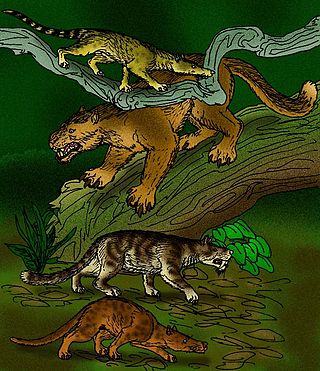
Creodonta is a former order of extinct carnivorous placental mammals that lived from the early Paleocene to the late Miocene epochs in North America, Europe, Asia and Africa. Originally thought to be a single group of animals ancestral to the modern Carnivora, this order is now usually considered a polyphyletic assemblage of two different groups, the oxyaenids and the hyaenodontids, not a natural group. Oxyaenids are first known from the Palaeocene of North America, while hyaenodonts hail from the Palaeocene of Africa.
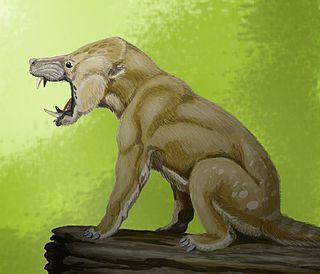
Condylarthra is an informal group – previously considered an order – of extinct placental mammals, known primarily from the Paleocene and Eocene epochs. They are considered early, primitive ungulates. It is now largely considered to be a wastebasket taxon, having served as a dumping ground for classifying ungulates which had not been clearly established as part of either Perissodactyla or Artiodactyla, being composed thus of several unrelated lineages.

Mesonychia is an extinct taxon of small- to large-sized carnivorous ungulates related to artiodactyls. Mesonychians first appeared in the early Paleocene, went into a sharp decline at the end of the Eocene, and died out entirely when the last genus, Mongolestes, became extinct in the early Oligocene. In Asia, the record of their history suggests they grew gradually larger and more predatory over time, then shifted to scavenging and bone-crushing lifestyles before the group became extinct.
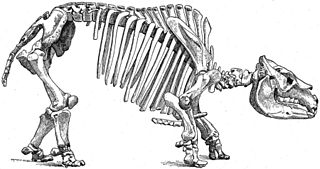
Notoungulata is an extinct order of ungulates that inhabited South America from the early Paleocene to the end of the Pleistocene, living from approximately 61 million to 11,000 years ago. Notoungulates were morphologically diverse, with forms resembling animals as disparate as rabbits and rhinoceroses. Notoungulata are the largest group of South American native ungulates, with over 150 genera in 14 families having been described, divided into two major subgroupings, Typotheria and Toxodontia. Notoungulates first diversified during the Eocene. Their diversity declined from the late Neogene onwards, with only the large toxodontids persisting until the end of the Pleistocene, perishing as part of the Late Pleistocene megafauna extinctions along with most other large mammals across the Americas. Collagen sequence analysis suggests that notoungulates are closely related to litopterns, another group of South American ungulates, and their closest living relatives being perissodactyls, including rhinoceroses, tapirs and equines as part of the clade Panperissodactyla. However their relationships to other South American ungulates are uncertain. Several groups of notoungulates separately evolved ever-growing cheek teeth.

Plesiadapis is one of the oldest known primate-like mammal genera which existed about 58–55 million years ago in North America and Europe. Plesiadapis means "near-Adapis", which is a reference to the adapiform primate of the Eocene period, Adapis. Plesiadapis tricuspidens, the type specimen, is named after the three cusps present on its upper incisors.

Ectoconus is an extinct genus of terrestrial herbivorous mammal of the family Periptychidae, endemic to North America during the Early Paleocene subepochs existing for approximately 2.7 million years. its skull is about 16 cm in length.
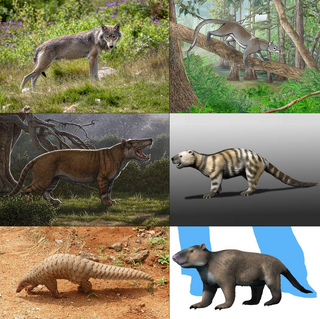
Ferae is a mirorder of placental mammals from grandorder Ferungulata, that groups together clades Pan-Carnivora, which includes modern carnivorans, and Pholidotamorpha, which includes pangolins.

Arctocyon is an extinct genus of ungulate mammals. Arctocyon was a "ground dwelling omnivore", that lived from 61.3-56.8 Ma. Synonyms of Arctocyon include Claenodon, and Neoclaenodon. Arctocyon was likely plantigrade, meaning that it walked with its feet flat on the ground, rather than on its toes.
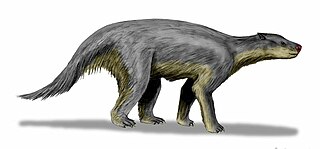
Pantodonta is an extinct suborder of eutherian mammals. These herbivorous mammals were one of the first groups of large mammals to evolve after the end of the Cretaceous. The last pantodonts died out at the end of the Eocene.

Cimolestes is a genus of early eutherians with a full complement of teeth adapted for eating insects and other small animals. Paleontologists have disagreed on its relationship to other mammals, in part because quite different animals were assigned to the genus, making Cimolestes a grade taxon of animals with similar features rather than a genus of closely related ones. Fossils have been found in North America, South America, Europe and Africa. Cimolestes first appeared during the Late Cretaceous of North America. According to some paleontologists, Cimolestes died out at the start of the Paleocene, while others report the genus from the early Eocene.

Ernanodon is an extinct genus of placental mammal from extinct family Ernanodontidae within extinct order Palaeanodonta, that lived from the middle to late Paleocene in China and Mongolia.

Arctocyonidae is as an extinct family of unspecialized, primitive mammals with more than 20 genera. Animals assigned to this family were most abundant during the Paleocene, but extant from the late Cretaceous to the early Eocene . Like most early mammals, their actual relationships are very difficult to resolve. No Paleocene fossil has been unambiguously assigned to any living order of placental mammals, and many genera resemble each other: generalized robust, not very agile animals with long tails and all-purpose chewing teeth, living in warm closed-canopy forests with many niches left vacant by the K-T extinction.

The Phaethontiformes are an order of birds. They contain one extant family, the tropicbirds (Phaethontidae), and one extinct family Prophaethontidae from the early Cenozoic. Several fossil genera have been described, with well-preserved fossils known as early as the Paleocene. The group's origins may lie even earlier if the enigmatic waterbird Novacaesareala from the latest Cretaceous or earliest Paleocene of New Jersey is considered a tropicbird.

Tillodontia is an extinct suborder of eutherian mammals known from the Early Paleocene to Late Eocene of China, the Late Paleocene to Middle Eocene of North America where they display their maximum species diversity, the Middle Eocene of Pakistan, and the Early Eocene of Europe. Leaving no descendants, they are most closely related to the pantodonts, another extinct group. The tillodonts were medium- to large-sized animals that probably fed on roots and tubers in temperate to subtropical habitats.

Apatemyidae is an extinct family of placental mammals that took part in the first placental evolutionary radiation together with other early mammals such as the leptictids. Their relationships to other mammal groups are controversial; a 2010 study found them to be basal members of Euarchontoglires.

Phenacodontidae is an extinct family of large herbivorous mammals traditionally placed in the “wastebasket taxon” Condylarthra, which may instead represent early-stage perissodactyls. They lived from the late early Paleocene to early middle Eocene and their fossil remains have been found in North America and Europe. The only unequivocal Asian phenacodontid is Lophocion asiaticus.

Ignacius is a genus of extinct mammal from the early Cenozoic era. This genus is present in the fossil record from around 62-33 Ma. The earliest known specimens of Ignacius come from the Torrejonian of the Fort Union Formation, Wyoming and the most recent known specimens from Ellesmere Island in northern Canada. Ignacius is one of ten genera within the family Paromomyidae, the longest living family of any plesiadapiforms, persisting for around 30 Ma during the Paleocene and Eocene epochs. The analyses of postcranial fossils by paleontologists suggest that members of the family Paromomyidae, including the genus Ignacius, most likely possessed adaptations for arboreality.
Azygonyx was a small tillodont mammal, likely the size of a cat to raccoon, that lived in North America during the Paleocene and Eocene in the early part of the Cenozoic Era. The only fossils that have been recovered are from the Willwood and Fort Union Formations in the Bighorn Basin of Wyoming, United States, and date to the Clarkforkian to Wasatchian, about 56 to 50 million years ago. Fifty-six collections that have been recovered thus far include the remains of Azygonyx. Azygonyx survived the Paleocene Eocene Thermal Maximum along with other mammals like Phenacodus and Ectocion, both of which were ground-dwelling mammals. Azygonyx probably was a generalist terrestrial mammal that may have roamed around the ground, but was also capable of climbing trees.
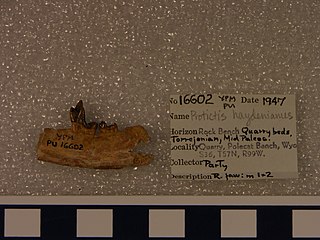
Protictis is an extinct paraphyletic genus of placental mammals from extinct subfamily Didymictinae within extinct family Viverravidae, that lived in North America from early Paleocene to middle Eocene.
Torrejonia is a genus of extinct plesiadapiform that belongs to the family Palaechthonidae. There are currently two species known, T. wilsoni and T. sirokyi. This genus is present in the fossil record from around 62–58 Ma. Species belonging to this genus are suggested to be plesiadapiforms based on adaptations observed in the skeletal morphology consistent with arboreal locomotor behavior. Following the mass extinction event at the Cretaceous–Paleogene boundary (K-Pg), a large diversity of plesiadapiform families were documented beginning at the Torrejonian NALMA. Research has shown that T. wilsoni is one of the largest palaechthonids and is reconstructed as being more frugivorous than other palaechthonids.
















